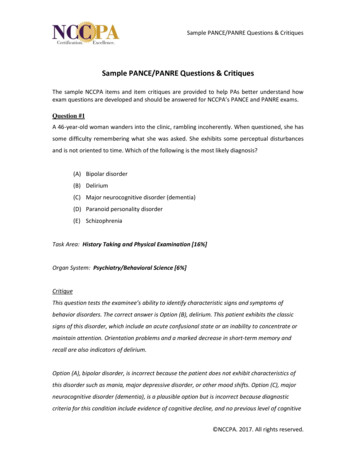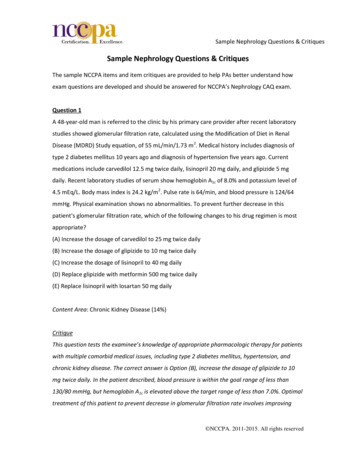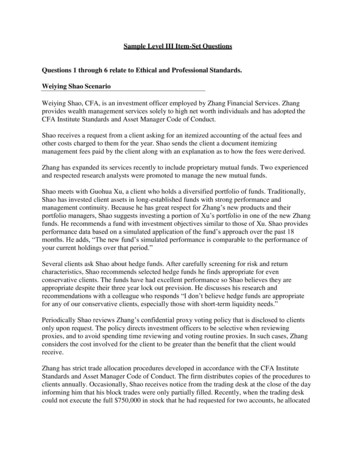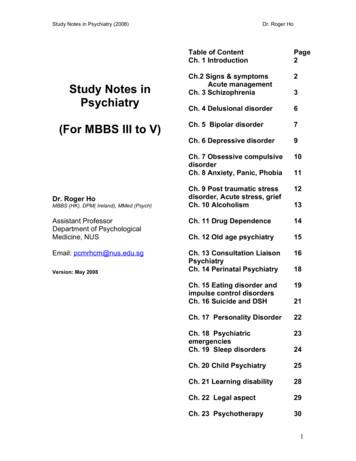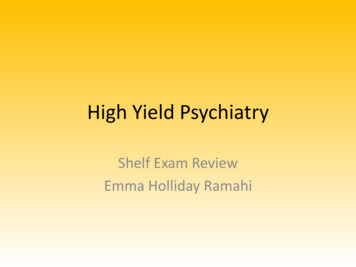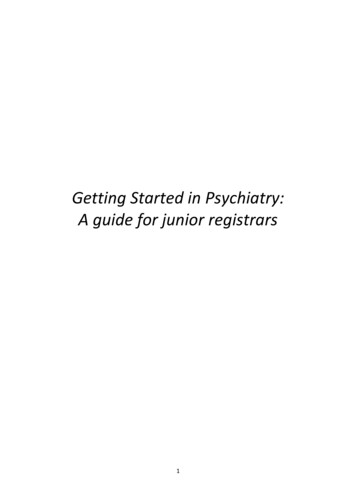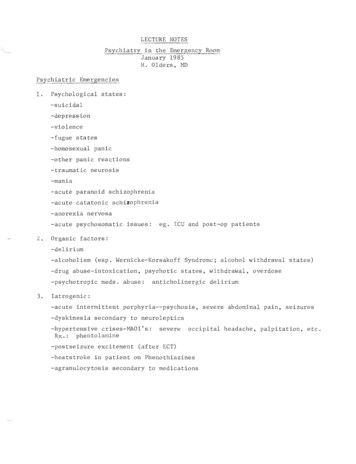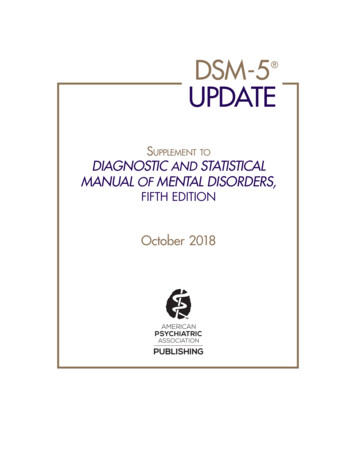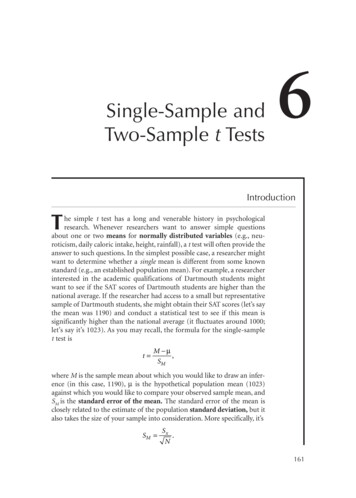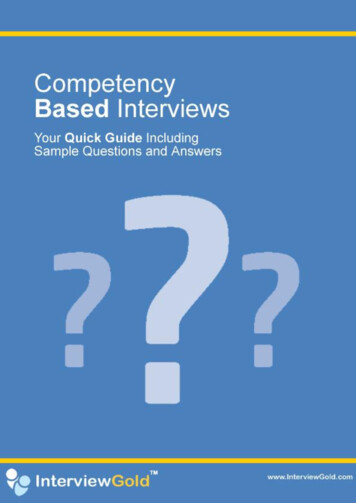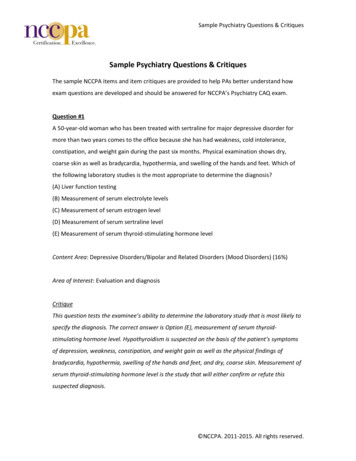
Transcription
Sample Psychiatry Questions & CritiquesSample Psychiatry Questions & CritiquesThe sample NCCPA items and item critiques are provided to help PAs better understand howexam questions are developed and should be answered for NCCPA’s Psychiatry CAQ exam.Question #1A 50-year-old woman who has been treated with sertraline for major depressive disorder formore than two years comes to the office because she has had weakness, cold intolerance,constipation, and weight gain during the past six months. Physical examination shows dry,coarse skin as well as bradycardia, hypothermia, and swelling of the hands and feet. Which ofthe following laboratory studies is the most appropriate to determine the diagnosis?(A) Liver function testing(B) Measurement of serum electrolyte levels(C) Measurement of serum estrogen level(D) Measurement of serum sertraline level(E) Measurement of serum thyroid-stimulating hormone levelContent Area: Depressive Disorders/Bipolar and Related Disorders (Mood Disorders) (16%)Area of Interest: Evaluation and diagnosisCritiqueThis question tests the examinee’s ability to determine the laboratory study that is most likely tospecify the diagnosis. The correct answer is Option (E), measurement of serum thyroidstimulating hormone level. Hypothyroidism is suspected on the basis of the patient’s symptomsof depression, weakness, constipation, and weight gain as well as the physical findings ofbradycardia, hypothermia, swelling of the hands and feet, and dry, coarse skin. Measurement ofserum thyroid-stimulating hormone level is the study that will either confirm or refute thissuspected diagnosis. NCCPA. 2011-2015. All rights reserved.
Sample Psychiatry Questions & CritiquesOption (A), liver function testing, is a plausible choice based on the patient’s signs and symptomsof weakness, weight gain, and swelling of the hands and feet. However, liver function testingdoes not address the remaining findings in the patient and, therefore, is incorrect. Option (B),measurement of serum electrolyte levels, is incorrect because although it is included in generaldiagnostic testing, this study would not specify a diagnosis considering the patient’s symptoms.Option (C), measurement of serum estrogen level, is a plausible choice considering the patient’sage and the signs and symptoms of dry skin and depression, but it does not address theremaining findings. Option (D), measurement of serum sertraline level, is plausible becauseadverse effects can include dryness of the mouth, cardiac abnormalities, and lack of energy.However, measurement of serum sertraline level does not address the remaining findings in thispatient and is, therefore, incorrect.Question #2A 35-year-old man with bipolar disorder, most recent episode mixed, comes to the clinic forroutine follow-up examination. His condition has been difficult to control and has requiredtreatment with multiple medications during the past two years. The patient says his mood hasbeen stable with his current regimen, but for the past three months, he has had tremorprimarily affecting his hands. Which of the following medications is the most likely cause of thispatient's tremor?(A) Carbamazepine(B) Gabapentin(C) Lamotrigine(D) Lithium carbonate(E) TopiramateContent Area: Depressive Disorders/Bipolar and Related Disorders (Mood Disorders) (16%)Area of Interest: Psychopharmacology NCCPA. 2011-2015. All rights reserved.
Sample Psychiatry Questions & CritiquesCritiqueThis question tests the examinee’s ability to recognize the indications for and adverse effects ofpsychopharmacologic agents. The correct answer is Option (D), lithium carbonate. Lithiumcarbonate is approved by the Food and Drug Administration for management of bipolar Idisorder and is the most commonly used pharmacologic therapy for that condition. Tremor, asnoted in the patient’s history, is a common adverse effect of lithium carbonate. Such tremor isseen in the fingers of the outstretched hands, usually at a frequency of 8 to 10 Hz, and issometimes related to peak serum lithium levels. Dividing the dose of lithium carbonate anddecreasing caffeine intake can decrease the tremor. In the case of a severe coarse tremor,lithium carbonate toxicity (serum lithium level greater than 2.5 mEq/L) must be ruled out.Option (A), carbamazepine, Option (C), lamotrigine, and Option (E), topiramate, are incorrectbecause even though they are used off-label for management of bipolar disorder, tremor is notcaused by these medications. Option (B), gabapentin, is incorrect because even though tremormay occur as an adverse effect of this medication, it is not prescribed for management of bipolardisorder.Question #3A 19-year-old woman who is a college student is brought to the clinic by her roommate becauseshe has been acting strangely during the past six months. During the past month, the patient hasbeen describing how another person's thoughts have been entering into her mind. The patient'sgrades have been slipping, and she does not talk as much as she did previously. The roommatesays that when the patient does talk, she strays from the topic and is hard to follow. During theinterview, the patient says a television reporter told her that the government had a specialmessage for her and she should listen to the radio for further instructions. Which of thefollowing conditions is the most likely cause of this patient's symptoms?(A) Acute stress disorder(B) Delusional disorder(C) Schizoaffective disorder(D) Schizophrenia(E) Schizophreniform disorder NCCPA. 2011-2015. All rights reserved.
Sample Psychiatry Questions & CritiquesContent Area: Schizophrenia Spectrum and Other Psychotic Disorders/Other Mental Disorders(Schizophrenia and Other Psychotic Disorders) (14%)Area of Interest: Evaluation and diagnosisCritiqueThis question tests the examinee’s ability to discriminate between characteristics of behaviordisorders. The correct answer is Option (D), schizophrenia. The patient has had classic symptomsof schizophrenia for at least six months, including hallucinations (voices speaking to her), socialdysfunction affecting grades and friendships, and disorganized speech. Although the patient issomewhat young for schizophrenia (peak incidence in women is between 25 and 35 years), hersymptoms meet the DSM criteria for the condition.Option (A), acute stress disorder, is incorrect because there is no evidence that the patient hasendured or witnessed a traumatic event or expressed intense fear, helplessness, or horror inresponse to such an event. Option (B), delusional disorder, is incorrect because the patient’sdelusions are bizarre in nature (for example, a television reporter telling her to listen to the radiofor a message and instructions from the government). However, in patients with delusionaldisorder, delusions are typically plausible, such as the belief that one is being followed. Option(C), schizoaffective disorder, is plausible but can be ruled out based on the fact that there is noevidence of concurrent manic or depressive symptoms during the schizophrenic episodedescribed. Option (E), schizophreniform disorder, is also plausible but can be ruled out based onthe six-month duration of symptoms. To meet criteria for schizophreniform disorder, symptomsmust persist for at least one month but fewer than six months.Question #4A 37-year-old man comes to the office after he experienced what he says was a nervousbreakdown. The patient says that after he recently declared bankruptcy, losing his home and hisbusiness, he became very depressed. During this time, he began to hear voices telling him thathe was useless and should kill himself. The patient says his symptoms stopped after NCCPA. 2011-2015. All rights reserved.
Sample Psychiatry Questions & Critiquesapproximately one week. He has had no similar episodes. Medical history includes no psychiatricconditions. Physical examination shows no abnormalities, and results of laboratory studies arewithin normal limits. Which of the following is the most likely diagnosis?(A) Borderline personality disorder(B) Brief psychotic disorder(C) Major depressive disorder with psychotic features(D) Schizophrenia(E) Schizophreniform disorderContent Area: Schizophrenia Spectrum and Other Psychotic Disorders/Other Mental Disorders(Schizophrenia and Other Psychotic Disorders) (14%)Area of Interest: Evaluation and diagnosisCritiqueThis question tests the examinee’s ability to distinguish between disorders that may present withpsychotic symptoms. The correct answer is Option (B), brief psychotic disorder. Essential featuresof brief psychotic disorder include sudden onset of one or more of the following symptoms:delusions, hallucinations, disorganized speech, disorganized behavior, and catatonia. Briefpsychotic disorder is also characterized by duration of symptoms for at least one day but lessthan one month followed by return to premorbid level of functioning. The disorder is notassociated with a medical condition or the effect of illicit substances such as hallucinogens.Option (A), borderline personality disorder, is incorrect because although it may present withstress-related paranoid ideation, this condition is transient. Option (C), major depressive disorderwith psychotic features, is incorrect because a diagnosis of major depressive disorder requiresthe presence of symptoms meeting diagnostic criteria for most of the day, nearly every day, andfor at least two weeks. Option (D), schizophrenia, and Option (E), schizophreniform disorder, arealso incorrect because the short duration of the patient’s symptoms (one week) does not meetcriteria for these conditions. NCCPA. 2011-2015. All rights reserved.
Sample Psychiatry Questions & CritiquesQuestion #5A 28-year-old man comes to the office because he has had severe restlessness, anxiety, andgeneralized myalgia during the past three days. The patient says he has not slept for the pasttwo days. Physical examination shows dilation of the pupils, excessive lacrimation, diaphoresis,and piloerection. The most likely cause of this patient's condition is withdrawal of which of thefollowing substances?(A) Cocaine(B) Inhalants(C) Methamphetamines(D) Modafinil(E) OpioidsContent Area: Substance-Related and Addictive Disorders (Substance-Related Disorders) (13%)Area of Interest: PsychopharmacologyCritiqueThis question tests the examinee’s ability to identify history and physical examination findings aswell as symptoms related to substance withdrawal. The correct answer is Option (E), opioids.Insomnia, dilation of the pupils, piloerection, diaphoresis, lacrimation or rhinorrhea, and myalgiaare classic symptoms of opioid withdrawal.Option (A), cocaine, is incorrect because symptoms of cocaine withdrawal include fatigue, vividdreams, increased appetite, and psychomotor retardation or agitation. Option (B), inhalants, isincorrect because withdrawal syndrome from inhalants is characterized by disturbed sleep,irritability, hallucinations, and delusions, nausea and vomiting, diaphoresis, and tachycardia.Option (C), methamphetamines, is incorrect because withdrawal from methamphetamines ischaracterized by any two of the following: lethargy, fatigue, psychomotor retardation oragitation, craving for stimulants, increased appetite, insomnia or hypersomnia, and bizarre orunpleasant dreams. Option (D), modafinil, is incorrect because withdrawal of this medication,which is used to treat narcolepsy, would cause sleepiness (not insomnia). NCCPA. 2011-2015. All rights reserved.
Sample Psychiatry Questions & CritiquesQuestion #6A 48-year-old man comes to the office for annual physical examination. The patient has smokedone pack of cigarettes daily for the past 20 years and says he wants to quit. He has tried to quitseveral times, but every time he does, he has depressed mood, difficulty sleeping, anxiety,restlessness, and increased appetite. The patient says these symptoms are so severe that he isunable to function well at work. Which of the following is the most appropriate therapy to aid insmoking cessation for this patient?(A) Alprazolam(B) Diazepam(C) Nicotine transdermal patches(D) Nicotinic acid(E) VareniclineContent Area: Substance-Related and Addictive Disorders (Substance-Related Disorders) (13%)Area of Interest: PsychopharmacologyCritiqueThis question tests the examinee’s ability to determine the most appropriate pharmaceuticaltherapy to aid in cessation of cigarette smoking in a patient with potential psychiatric disorders.The correct answer is Option (C), nicotine transdermal patches. Nicotine transdermal patchesused as an aid in smoking cessation are not likely to exacerbate a patient’s symptoms ofdepression, anxiety, or sleep disturbance.Option (A), alprazolam, and Option (B), diazepam, are incorrect because although they may beplausible therapies for anxiety, these medications are not approved for smoking cessation.Option (D), nicotinic acid, is incorrect because this medication, which is used in conjunction withlow-fat diet to manage hypercholesterolemia, is neither approved nor effective for smokingcessation. Option (E), varenicline, is a plausible choice because it is approved for smokingcessation. However, therapy with varenicline is not advisable in patients who have psychiatricdisorders because it has the potential to exacerbate agitation and depression. NCCPA. 2011-2015. All rights reserved.
Sample Psychiatry Questions & CritiquesQuestion #7A 55-year-old woman comes to the office because she has a 20-year history of repetitive actionsand is tired of wasting time by repeating these actions. The patient says she repeatedly checksthe doors in her house to make sure they are locked, washes her hands several times per hour,and checks her electrical appliances three times each morning before she leaves for work.Medical history includes second-degree atrioventricular block. Which of the followingmedications is the most appropriate initial therapy for this patient's psychiatric disord
This question tests the examinee’s ability to determine the laboratory study that is most likely to specify the diagnosis. The correct answer is Option (E), measurement of serum thyroid-stimulating hormone level. Hypothyroidism is suspected on the basis of the patient’s symptoms of depression, weakness, constipation, and weight gain as well as the physical findings of bradycardia .
